
Nov . 29, 2024 20:49 Back to list
Guidelines for Installing a Hot Water Boiler Effectively and Safely
Hot Water Boiler Installation A Comprehensive Guide
When it comes to heating solutions for residential or commercial properties, hot water boilers remain a preferred choice due to their efficiency and effectiveness in providing consistent warmth. Installing a hot water boiler can be a significant investment, and understanding the installation process is crucial for ensuring optimal performance and longevity of the system. This article aims to guide you through the steps of hot water boiler installation, along with some helpful tips.
1. Choosing the Right Boiler
Before you begin the installation process, it's essential to select the right type of hot water boiler for your needs. There are several types to consider, including
- Conventional Boilers These require a large space for installation and typically use a tank to store hot water. - Combi Boilers Compact and efficient, these boilers provide both heating and hot water on demand. - System Boilers Similar to conventional boilers but include additional components that make them more efficient.
Factors such as the size of your home, the number of bathrooms, and your heating preferences should influence your choice.
Preparing for the installation involves several critical steps
hot water boiler installation

- Choose the Location The boiler should be installed in a dry, well-ventilated area. Common locations include basements, utility rooms, or garages. Ensure there’s sufficient space for maintenance and servicing access. - Check Local Regulations Before proceeding, check local building codes and regulations. Different regions have specific requirements regarding boiler installations, including safety standards and permits. - Gather Necessary Tools and Materials Typical tools include a drill, wrenches, screwdrivers, and a level. Materials may involve pipes, valves, fittings, and, of course, the boiler unit.
3. Installation Steps
The installation process can vary based on the type of boiler, but here is a general outline of the steps involved
- Disconnect the Old Boiler (if applicable) If you are replacing an old unit, carefully disconnect and remove it. Ensure that the water and power supply are turned off before this step. - Install the Mounting Bracket For wall-mounted boilers, install the bracket at a recommended height to ensure the unit is securely held in place. - Connect the Pipes Carefully connect the water supply pipes, ensuring that you follow the manufacturer's guidelines concerning copper, PVC, or PEX pipes. Make sure to use the appropriate fittings and adhesives where necessary. - Set Up the Boiler Unit Place the boiler on the mounting bracket or on its designated platform. You’ll then need to connect it to the power supply, including any necessary safety devices like an expansion tank or pressure relief valve. - Fill the Boiler After connections are made, fill the boiler with water while checking for leaks. Ensure that all valves and fittings are tight and secure. - Bleed the Radiators To remove trapped air, bleed the radiators in your heating system. This step ensures that hot water circulates effectively throughout your home. 4. Testing and Maintenance
Once installation is complete, it’s crucial to test the system
- Turn on the Boiler Start the boiler and check for any irregular sounds or leaks. Monitor the pressure gauge to ensure it operates within the recommended range. - Check the Thermostat Ensure that the thermostat is programmed correctly and responds to temperature changes as expected. - Annual Maintenance Schedule regular maintenance checks with a qualified technician to ensure the boiler operates efficiently and safely. This will help prolong the life of the unit and maintain optimal performance.
Conclusion
Installing a hot water boiler can significantly enhance your home’s comfort. However, it's essential to proceed with caution and adhere to safety standards throughout the installation process. If you are unsure at any point, it is advisable to consult with or hire a professional installer. By following the right procedures and conducting regular maintenance, your hot water boiler can provide reliable service for years to come.
-
High-Efficiency Commercial Oil Fired Steam Boiler for Industry
NewsJul.30,2025
-
High-Efficiency Biomass Fired Thermal Oil Boiler Solutions
NewsJul.30,2025
-
High Efficiency Gas Fired Thermal Oil Boiler for Industrial Heating
NewsJul.29,2025
-
High-Efficiency Gas Fired Hot Water Boiler for Sale – Reliable & Affordable
NewsJul.29,2025
-
High Efficiency Biomass Fired Hot Water Boiler for Industrial and Commercial Use
NewsJul.29,2025
-
High-Efficiency Biomass Fired Hot Water Boiler for Industrial Use
NewsJul.28,2025
Related PRODUCTS






















